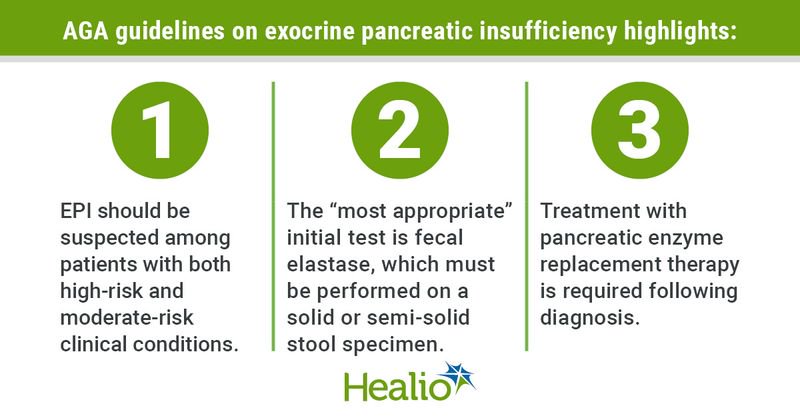AGA: Early diagnosis, treatment ‘essential’ in exocrine pancreatic insufficiency
Key takeaways:
- Exocrine pancreatic insufficiency should be suspected among patients with high-risk clinical conditions, such as chronic pancreatitis.
- Treatment with pancreatic enzyme replacement therapy is required for EPI.
Citing an “urgent need” for best practice updates to improve awareness and treatment for exocrine pancreatic insufficiency, the AGA has published new guidance to aid clinicians in evaluation and management of the disease.
“EPI is frequently underdiagnosed and, as a result, patients are often not treated appropriately,” David C. Whitcomb, MD, PhD, of the division of gastroenterology, hepatology and nutrition at the University of Pittsburgh, and colleagues wrote in Gastroenterology. “There is an urgent need to increase awareness of and treatment for this condition.”

In an expert review, members of the AGA Institute Clinical Practice Updates Committee gathered evidence from published literature and expert opinion to develop 15 best practice advice statements for the diagnosis and management of exocrine pancreatic insufficiency (EPI). As systematic reviews were not performed, the statements “do not carry formal ratings regarding the quality of evidence or strength of the presented considerations,” researchers wrote.
Highlights include:
- EPI should be suspected among patients with high-risk clinical conditions, including chronic pancreatitis, relapsing acute pancreatitis, pancreatic ductal adenocarcinoma, cystic fibrosis and previous pancreatic surgery.
- EPI also should be considered among those with moderate-risk clinical conditions, such as duodenal diseases, previous intestinal surgery, longstanding diabetes mellitus and hypersecretory states.
- Clinical features and symptoms include steatorrhea with or without diarrhea, weight loss, bloating, excessive flatulence, fat-soluble vitamin deficiencies and protein-calorie malnutrition.
- The “most appropriate” initial test is fecal elastase, which must be performed on a solid or semi-solid stool specimen. A fecal elastase level of less than 100 µg/g of stool provides good evidence of EPI, while levels of 100 µg/g to 200 µg/g are indeterminate.
- Following diagnosis, treatment with pancreatic enzyme replacement therapy (PERT) is required and routine supplementation and monitoring of vitamin levels are also appropriate. Dietary modifications include a low to moderate fat diet with frequent smaller meals and avoidance of very low-fat diets.
- Measures of successful treatment with PERT include reduction in steatorrhea and associated GI symptoms; gains in weight, muscle mass and muscle function; and improved fat-soluble vitamin levels.
- EPI should be monitored and compared with baseline measurements of nutritional status such as BMI, quality of life and fat-soluble vitamin levels; baseline dual-energy x-ray absorptiometry scan should be repeated annually or every 2 years.
“It is essential to diagnose this condition early and initiate treatment as soon as the diagnosis is made, to reduce the long-term consequences of untreated EPI,” Whitcomb and colleagues concluded. “Despite severe outcomes, EPI management remains suboptimal, underscoring the importance of raising awareness in high-risk patients, developing better diagnostics tests, improving access to PERT for patients and developing newer and more potent agents.”
They continued: “Effective management of patients with EPI requires broader implementation of diagnostic tools and treatment optimization.”
